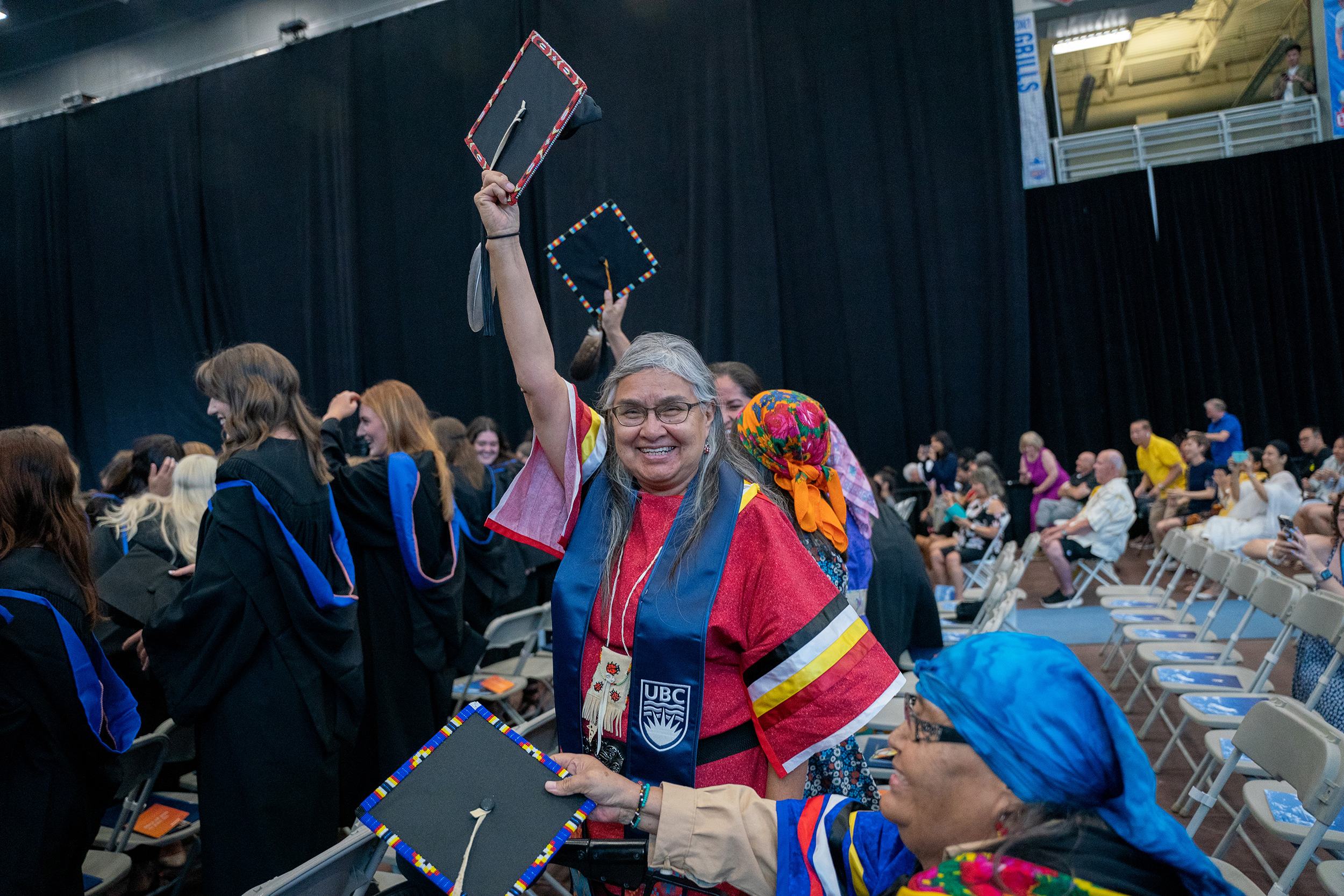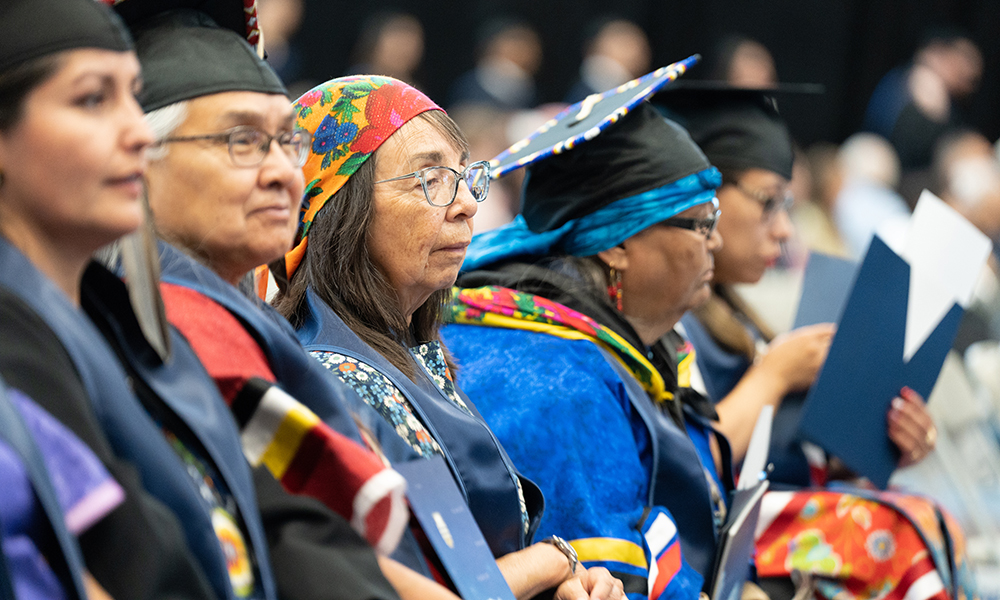
ROSE CALDWELL FINALLY HAS THE WORDS OTHERS TRIED TO KEEP FROM HER. A member of Westbank First Nation and a UBC Okanagan graduate, Caldwell didn’t grow up speaking her own language—Nsyilxcn—so she committed to learning it herself.
“I come from a family of eight,” says Caldwell. “They’re all fluent speakers, but residential school stopped it with my two younger brothers and me. It was a real trauma for me. I had a chip on my shoulder because of it. I thought, ‘Why not me? Why wasn’t I good enough to learn my language?’
“I realized later the only way I would learn would be to take the classes myself.”
That innermost journey eventually landed her in the Bachelor of Nsyilxcn Language Fluency (BNLF) program, where she became part of the first-ever graduating cohort from UBCO.
Caldwell says with a smile that she’s now “98 per cent” fluent after earning her BNLF degree, a milestone that the eight students achieved thanks to the work of a great number of partners. BNLF is an innovative collaboration that begins at Nicola Valley Institute of Technology (NVIT) in Merritt. Students earn a certificate after one year and a diploma after two years.

Members of UBCO’s first-ever Bachelor of Nsyilxcn Language Fluency degree celebration at graduation.
They then transfer their credits to UBC Okanagan to pursue a four-year Bachelor’s degree in the Irving K. Barber Faculty of Arts and Social Sciences. However, most of their learning happened at the En’owkin Centre in Penticton, an Indigenous, adult higher-learning institution governed by the Okanagan Indian Educational Resources Society.
Both the Indigenous Adult and Higher Learning Association and the First Nations Education Steering Committee helped inform the framework upon which the BNLF program was built. At its core, BNLF strives to represent all the Okanagan Nation Alliance.
As much hard work happens once students begin their education. Earning a UBC degree was emotional and challenging, Caldwell says, but the four years were also filled with deep connections between students, faculty and staff.
No others had come before them, and there wasn’t another Indigenous language program like it in Canada when they started.
They had no choice but to rely on each other. They had to create resource and learning materials from scratch because there were no textbooks to pull off a shelf.
Instead, they listened to archival recordings of Elders speaking Nsyilxcn. They transliterated and transcribed what they heard and brought the recordings or transcriptions into class to discuss them.
They explored why Elders chose the words they did and the meaning behind those choices. Caldwell described it as “overwhelmingly fulfilling. It’s like you’ve found your place. You’ve rediscovered your place. You belong.

Member of the first Bachelor of Nsyilxcn Language Fluency degree attend graduation ceremonies at UBC Okanagan.
UBCO Associate Professor Dr. Jeannette Armstrong, the program’s academic lead, says she wants others to know that BNLF isn’t just about learning a language, though. BNLF offers a wide-ranging education.
“It’s critical that people understand that BNLF is about preparing students for careers and further education,” Dr. Armstrong says. “It’s the only program of its kind in the world. We’re very, very proud of that. It took much collaboration and much partnership.”
She says it’s fitting that BNLF came to life at three schools because BNLF students represent all of Syilx Nation. UBCO and En’owkin are in the traditional, unceded and ancestral territory of the Syilx Okanagan peoples; NVIT is British Columbia’s Indigenous public, post-secondary institution and a long-time partner of En’owkin Centre.
BNLF is more important than ever because Indigenous language use is declining, according to the Canadian census. Statistics Canada said in 2021 that 237,420 Indigenous people in Canada reported they could carry out a conversation in their language. That number represents a 4.3 per cent decline from 2016.
However, more people are learning Indigenous languages as a second language. In 2021, almost 28 per cent of Indigenous language speakers did not grow up with it, a three per cent increase from 2016.
Language wasn’t the only consideration though. Taking into account community needs, educators designed BNLF to focus on three areas: Numeracy and Math, Literature and Performing Arts, and Traditional Ecological Knowledge. BNLF isn’t the result of efforts to Indigenize education, but rather it delivers Indigenous education, all in Nsyilxcn.
For example, Dr. Armstrong says that thousands of years of living on the land have sharpened and shaped the Indigenous classification systems of plants and animals.
She uses the example of the saskatoon berry, or siya. While some may think saskatoon berries are all the same, Indigenous knowledge keepers name at least seven plant varieties. Similar differences, she adds, exist between western and Indigenous understanding of salmon, water, forests and beyond.
“As soon as we look at them, the language fits,” Dr. Armstrong says. “It isn’t just about the language, but it’s all about the language.”
BNLF students didn’t wait until graduation to share what they learned with others, either, and stepped into their communities as part of graduating capstone projects.
They consulted Indigenous knowledge keepers to understand culturally significant stories, decoded the symbolism and meaning within each account, and then shared that in workshops for hundreds of Syilx ONA members as part of widely popular Indigenous learning forums.
Working together on projects, students quickly realized just how necessary it was to collaborate and how much they could achieve together.
Kathleen Michel from the Upper Nicola Band near Merritt says the BNLF changed everyone so considerably that graduation was bittersweet. Students formed deep relationships and became accustomed to working regularly together, she says. “We struggled for years to get where we are.”
Michel credits Dr. Armstrong for helping students persevere and realize what they could learn through the language. “She told us to talk to the land and the water to see what we wanted and needed. Once you start speaking the language, the healing will start, and you’ll see the connection to the land and your family. This whole place is our family.”
For Caldwell, it just so happens that she belongs among two families of eight. She’s one of eight siblings and eight BNLF classmates, and they all speak the same language.
“At one point or another, we all wanted to quit,” Caldwell says of her classmates. “But we leaned on each other. We checked on each other all the time. We worked very closely together.
“We’d go to each other’s houses when someone needed help and didn’t think they could go any further. We’d say, ‘You talk, and I’ll type. One way or another, we’ll get this paper written.’
“We’re all one,” she adds. “We will always be one. No matter what different directions our lives go, we can call on each other. It’s a lifelong responsibility to the people who’ve helped me become whole again.”
The first graduating cohort is kəɬk’əmpic’a Rose Caldwell from Westbank First Nation, snik̓ɬc̓aʔ tkɬmilxʷ Jordan Bower from Osoyoos Indian Band, pyaʕ Candice Gabriel from Penticton Indian Band, haʔmisms Morning Dove Hall from Osoyoos Indian Band, sknir̓mn Anona Kampe from Penticton and Syilx Okanagan Nation, Savannah Louis from Okanagan Indian Band, xʷəstalqs Kathleen Michel from Upper Nicola Indian Band and sq̓aʔx̌əx̌inak Sheri Stelkia from Osoyoos Indian Band.






